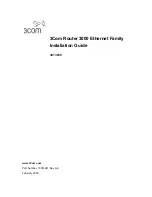
16. Ethernet Ports
ROX™ v2.2 User Guide
156
RuggedBackbone™ RX5000
Figure 16.5. Switched Ethernet Ports form
Slot
Synopsis: string - one of the following keywords { lm6, lm5, lm4, lm3, lm2, lm1, sm }
The name of the module location provided on the silkscreen across the top of the device.
Port
Synopsis: integer
The port number as seen on the front plate silkscreen of the switch (or a list of ports, if aggregated
in a port trunk).
Enabled
Synopsis: boolean
Default: true
Provides the option to enable or disable this interface. When unchecked(i.e disabled), the interface
will prevent all frames from being sent and received on that interface.
AutoN
Synopsis: string - one of the following keywords { off, on }
Enables or disables IEEE 802.3 auto-negotiation. Enabling auto-negotiation results in speed and
duplex being negotiated upon link detection; both end devices must be auto-negotiation compliant
for the best possible results.
Speed
Synopsis: string - one of the following keywords { 10M, 100M, 1G, 10G, auto }
Speed (in megabits-per-second or gigabits-per-second). If auto-negotiation is enabled, this is the
speed capability advertised by the auto-negotiation process. If auto-negotiation is disabled, the port
is explicitly forced to this speed mode. AUTO means advertise all supported speed modes.
Duplex
Synopsis: string - one of the following keywords { full, half, auto }
If auto-negotiation is enabled, this is the duplex capability advertised by the auto-negotiation
process. If auto-negotiation is disabled, the port is explicitly forced to this duplex mode. AUTO
means advertise all supported duplex modes.
Link Alarms
Synopsis: boolean
Default: true
















































